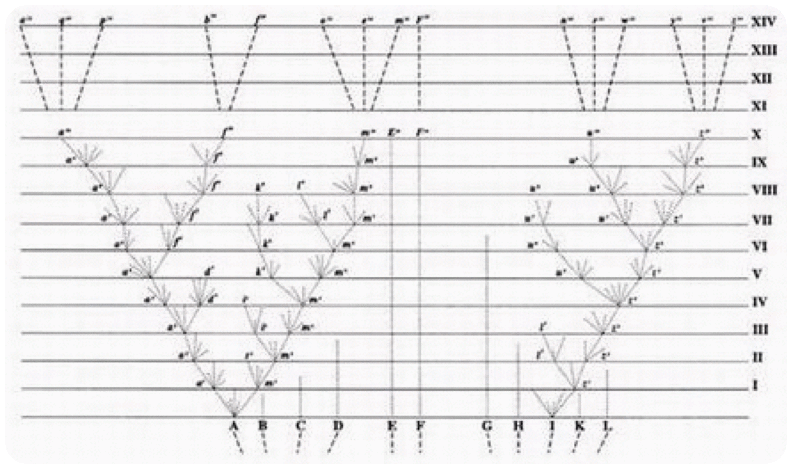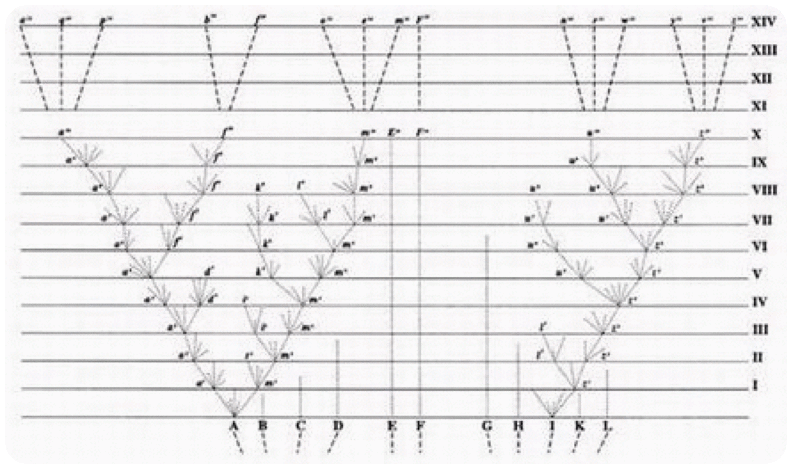5.5: Theory of Evolution
- Page ID
- 12107
\( \newcommand{\vecs}[1]{\overset { \scriptstyle \rightharpoonup} {\mathbf{#1}} } \)
\( \newcommand{\vecd}[1]{\overset{-\!-\!\rightharpoonup}{\vphantom{a}\smash {#1}}} \)
\( \newcommand{\dsum}{\displaystyle\sum\limits} \)
\( \newcommand{\dint}{\displaystyle\int\limits} \)
\( \newcommand{\dlim}{\displaystyle\lim\limits} \)
\( \newcommand{\id}{\mathrm{id}}\) \( \newcommand{\Span}{\mathrm{span}}\)
( \newcommand{\kernel}{\mathrm{null}\,}\) \( \newcommand{\range}{\mathrm{range}\,}\)
\( \newcommand{\RealPart}{\mathrm{Re}}\) \( \newcommand{\ImaginaryPart}{\mathrm{Im}}\)
\( \newcommand{\Argument}{\mathrm{Arg}}\) \( \newcommand{\norm}[1]{\| #1 \|}\)
\( \newcommand{\inner}[2]{\langle #1, #2 \rangle}\)
\( \newcommand{\Span}{\mathrm{span}}\)
\( \newcommand{\id}{\mathrm{id}}\)
\( \newcommand{\Span}{\mathrm{span}}\)
\( \newcommand{\kernel}{\mathrm{null}\,}\)
\( \newcommand{\range}{\mathrm{range}\,}\)
\( \newcommand{\RealPart}{\mathrm{Re}}\)
\( \newcommand{\ImaginaryPart}{\mathrm{Im}}\)
\( \newcommand{\Argument}{\mathrm{Arg}}\)
\( \newcommand{\norm}[1]{\| #1 \|}\)
\( \newcommand{\inner}[2]{\langle #1, #2 \rangle}\)
\( \newcommand{\Span}{\mathrm{span}}\) \( \newcommand{\AA}{\unicode[.8,0]{x212B}}\)
\( \newcommand{\vectorA}[1]{\vec{#1}} % arrow\)
\( \newcommand{\vectorAt}[1]{\vec{\text{#1}}} % arrow\)
\( \newcommand{\vectorB}[1]{\overset { \scriptstyle \rightharpoonup} {\mathbf{#1}} } \)
\( \newcommand{\vectorC}[1]{\textbf{#1}} \)
\( \newcommand{\vectorD}[1]{\overrightarrow{#1}} \)
\( \newcommand{\vectorDt}[1]{\overrightarrow{\text{#1}}} \)
\( \newcommand{\vectE}[1]{\overset{-\!-\!\rightharpoonup}{\vphantom{a}\smash{\mathbf {#1}}}} \)
\( \newcommand{\vecs}[1]{\overset { \scriptstyle \rightharpoonup} {\mathbf{#1}} } \)
\( \newcommand{\vecd}[1]{\overset{-\!-\!\rightharpoonup}{\vphantom{a}\smash {#1}}} \)
\(\newcommand{\avec}{\mathbf a}\) \(\newcommand{\bvec}{\mathbf b}\) \(\newcommand{\cvec}{\mathbf c}\) \(\newcommand{\dvec}{\mathbf d}\) \(\newcommand{\dtil}{\widetilde{\mathbf d}}\) \(\newcommand{\evec}{\mathbf e}\) \(\newcommand{\fvec}{\mathbf f}\) \(\newcommand{\nvec}{\mathbf n}\) \(\newcommand{\pvec}{\mathbf p}\) \(\newcommand{\qvec}{\mathbf q}\) \(\newcommand{\svec}{\mathbf s}\) \(\newcommand{\tvec}{\mathbf t}\) \(\newcommand{\uvec}{\mathbf u}\) \(\newcommand{\vvec}{\mathbf v}\) \(\newcommand{\wvec}{\mathbf w}\) \(\newcommand{\xvec}{\mathbf x}\) \(\newcommand{\yvec}{\mathbf y}\) \(\newcommand{\zvec}{\mathbf z}\) \(\newcommand{\rvec}{\mathbf r}\) \(\newcommand{\mvec}{\mathbf m}\) \(\newcommand{\zerovec}{\mathbf 0}\) \(\newcommand{\onevec}{\mathbf 1}\) \(\newcommand{\real}{\mathbb R}\) \(\newcommand{\twovec}[2]{\left[\begin{array}{r}#1 \\ #2 \end{array}\right]}\) \(\newcommand{\ctwovec}[2]{\left[\begin{array}{c}#1 \\ #2 \end{array}\right]}\) \(\newcommand{\threevec}[3]{\left[\begin{array}{r}#1 \\ #2 \\ #3 \end{array}\right]}\) \(\newcommand{\cthreevec}[3]{\left[\begin{array}{c}#1 \\ #2 \\ #3 \end{array}\right]}\) \(\newcommand{\fourvec}[4]{\left[\begin{array}{r}#1 \\ #2 \\ #3 \\ #4 \end{array}\right]}\) \(\newcommand{\cfourvec}[4]{\left[\begin{array}{c}#1 \\ #2 \\ #3 \\ #4 \end{array}\right]}\) \(\newcommand{\fivevec}[5]{\left[\begin{array}{r}#1 \\ #2 \\ #3 \\ #4 \\ #5 \\ \end{array}\right]}\) \(\newcommand{\cfivevec}[5]{\left[\begin{array}{c}#1 \\ #2 \\ #3 \\ #4 \\ #5 \\ \end{array}\right]}\) \(\newcommand{\mattwo}[4]{\left[\begin{array}{rr}#1 \amp #2 \\ #3 \amp #4 \\ \end{array}\right]}\) \(\newcommand{\laspan}[1]{\text{Span}\{#1\}}\) \(\newcommand{\bcal}{\cal B}\) \(\newcommand{\ccal}{\cal C}\) \(\newcommand{\scal}{\cal S}\) \(\newcommand{\wcal}{\cal W}\) \(\newcommand{\ecal}{\cal E}\) \(\newcommand{\coords}[2]{\left\{#1\right\}_{#2}}\) \(\newcommand{\gray}[1]{\color{gray}{#1}}\) \(\newcommand{\lgray}[1]{\color{lightgray}{#1}}\) \(\newcommand{\rank}{\operatorname{rank}}\) \(\newcommand{\row}{\text{Row}}\) \(\newcommand{\col}{\text{Col}}\) \(\renewcommand{\row}{\text{Row}}\) \(\newcommand{\nul}{\text{Nul}}\) \(\newcommand{\var}{\text{Var}}\) \(\newcommand{\corr}{\text{corr}}\) \(\newcommand{\len}[1]{\left|#1\right|}\) \(\newcommand{\bbar}{\overline{\bvec}}\) \(\newcommand{\bhat}{\widehat{\bvec}}\) \(\newcommand{\bperp}{\bvec^\perp}\) \(\newcommand{\xhat}{\widehat{\xvec}}\) \(\newcommand{\vhat}{\widehat{\vvec}}\) \(\newcommand{\uhat}{\widehat{\uvec}}\) \(\newcommand{\what}{\widehat{\wvec}}\) \(\newcommand{\Sighat}{\widehat{\Sigma}}\) \(\newcommand{\lt}{<}\) \(\newcommand{\gt}{>}\) \(\newcommand{\amp}{&}\) \(\definecolor{fillinmathshade}{gray}{0.9}\)
How do new species form?
This is the only illustration in Charles Darwin's 1859 book On the Origin of Species, showing his ideas describing the divergence of species from common ancestors.
Darwin’s Theory of Evolution by Natural Selection
Darwin spent many years thinking about the work of Lamarck, Lyell, and Malthus, what he had seen on his voyage, and artificial selection. What did all this mean? How did it all fit together? It fits together in Darwin’s theory of evolution by natural selection. It’s easy to see how all of these influences helped shape Darwin’s ideas.
Evolution of Darwin’s Theory
It took Darwin years to form his theory of evolution by natural selection. His reasoning went like this:
- Like Lamarck, Darwin assumed that species can change over time. The fossils he found helped convince him of that.
- From Lyell, Darwin saw that Earth and its life were very old. Thus, there had been enough time for evolution to produce the great diversity of life Darwin had observed.
- From Malthus, Darwin knew that populations could grow faster than their resources. This “overproduction of offspring” led to a “struggle for existence,” in Darwin’s words.
- From artificial selection, Darwin knew that some offspring have variations that occur by chance, and that can be inherited. In nature, offspring with certain variations might be more likely to survive the “struggle for existence” and reproduce. If so, they would pass their favorable variations to their offspring.
- Darwin coined the term fitness to refer to an organism’s relative ability to survive and produce fertile offspring. Nature selects the variations that are most useful. Therefore, he called this type of selection natural selection.
- Darwin knew artificial selection could change domestic species over time. He inferred that natural selection could also change species over time. In fact, he thought that if a species changed enough, it might evolve into a new species.
Wallace’s paper not only confirmed Darwin’s ideas. It also pushed him to finish his book, On the Origin of Species. Published in 1859, this book changed science forever. It clearly spelled out Darwin’s theory of evolution by natural selection and provided convincing arguments and evidence to support it.
Applying Darwin’s Theory
The following example applies Darwin’s theory. It explains how giraffes came to have such long necks (see Figure below).
- In the past, giraffes had short necks. But there was chance variation in neck length. Some giraffes had necks a little longer than the average.
- Then, as now, giraffes fed on tree leaves. Perhaps the environment changed, and leaves became scarcer. There would be more giraffes than the trees could support. Thus, there would be a “struggle for existence.”
- Giraffes with longer necks had an advantage. They could reach leaves other giraffes could not. Therefore, the long-necked giraffes were more likely to survive and reproduce. They had greater fitness.
- These giraffes passed the long-neck trait to their offspring. Each generation, the population contained more long-necked giraffes. Eventually, all giraffes had long necks.
 Giraffes feed on leaves high in trees. Their long necks allow them to reach leaves that other ground animals cannot.
Giraffes feed on leaves high in trees. Their long necks allow them to reach leaves that other ground animals cannot.As this example shows, chance variations may help a species survive if the environment changes. Variation among species helps ensure that at least one will be able to survive environmental change.
KQED: Chasing Beetles, Finding Darwin
It's been over 150 years since Charles Darwin published On the Origin of Species. Yet his ideas remain as central to scientific exploration as ever, and has been called the unifying concept of all biology. Is evolution continuing today? Of course it is.
QUEST follows researchers who are still unlocking the mysteries of evolution, including entomologist David Kavanaugh of the California Academy of Sciences, who predicted that a new beetle species would be found on the Trinity Alps of Northern California.
It's rare for a biologist to predict the discovery of a new species. For his prediction, Kavanaugh drew inspiration from Darwin's own 1862 prediction. When Darwin observed an orchid from Madagascar with a foot-long nectar, he predicted that a pollinator would be found with a tongue long enough to reach the nectar inside the orchid's very thin, elongated nectar ‘‘pouch’’, though he had never seen such a bird or insect. Darwin's prediction was based on his finding that all species are related to each other and that some of them evolve together, developing similar adaptations. Darwin's prediction came true in 1903, when a moth was discovered in Madagascar with a long, thin proboscis, which it uncurls to reach the nectar in the orchid's nectar. In the process of feeding from the orchid, the moth serves as its pollinator. The moth was given the scientific name Xanthopan morganii praedicta, in honor of Darwin’s prediction.
As you view Chasing Beetles, Finding Darwin, focus on the following concepts:
- the relationship between studying beetles and evolution,
- the development of new species,
- the relationship between genetic make-up of an organism and evolution,
- the role of beneficial mutations,
- the role of ‘‘habitat islands’’,
- the selection for certain traits among breeders, such as pigeon breeders,
- the importance of identifying new species.
Science Friday: Sex, Lies and Orchids
Orchids utilize a wide variety of techniques to manipulate other species into becoming their pollinators. In this video by Science Friday, curator Marc Hachadourian describes some of these deceptive methods.
Summary
- Darwin's book On the Origin of Species clearly spells out his theory.
- Darwin's book also provides evidence and logic to support that evolution occurs and that it occurs by natural selection.
Review
- Define fitness.
- Apply Darwin’s theory of evolution by natural selection to a specific case. For example, explain how Galápagos tortoises could have evolved saddle-shaped shells.
- Explain how the writings of Charles Lyell and Thomas Malthus helped Darwin develop his theory of evolution by natural selection.
- Discuss the role artificial selection had on Darwin's theory.
Resources
| Image | Reference | Attributions |
 |
[Figure 1] | Credit: William Warby;Ernst Haeckel;Common rock pigeon: Image copyright Marketa Mark, 2014; Carrier pigeon: Image copyright guentermanaus, 2014; Fantail pigeon: Image copyright Ulrike Haberkorn, 2014 Source: http://www.flickr.com/photos/wwarby/2405281800/ ; en.Wikipedia.org/wiki/File:Age-of-Man-wiki.jpg ; http://www.shutterstock.com License: Used under licenses from Shutterstock.com |
 |
[Figure 2] | Credit: William Warby Source: http://www.flickr.com/photos/wwarby/2405281800/ License: CC BY 2.0 |

